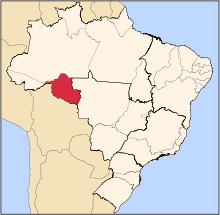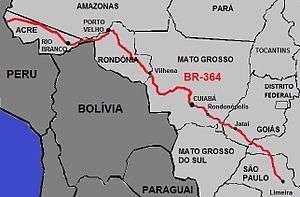Kwaza language
| Kwaza | |
|---|---|
| Koaiá | |
| Native to | Brazil |
| Region | Rondônia |
| Ethnicity | 40 Kwazá (2010?)[1] |
Native speakers | 7 (2010)[2] |
| Language codes | |
| ISO 639-3 |
xwa |
| Glottolog |
kwaz1243[3] |
Kwaza (also written Kwazá or Koaiá) is an endangered language spoken by the Kwaza people of Brazil.[4] Like many other languages in the area, it is an unclassified language, but there are hypothesized long-distance genetic relationships.[5]
Little is known about Kwaza people and language due to the minimal historical sources available; if mentioned in reliable documents, it is usually in reference to its neighbors.[5] What is known, is that the Kwaza people were at one point a fierce nation of a few thousands persons, which could be subdivided into various groups.[5]
As of 2005 there were only 25 known speakers[6] who make up two ethnically mixed families. They live South of the original habitat on the Indian reserve Tubarão-Latundê and speak Kwaza on a day-to-day basis.[7] Most of the speakers are trilingual in Aikanã and Portuguese[7]
Location

Historical
Due to the extremely limited documentation, combined with the semi-nomadic lifestyles of the Kwaza speakers and the lack of permanent settlements from a slash and burn agriculture, the historical location of the people is largely unknown. In addition, disease brought by Western contact and the imposed culture actively worked to destroy the local materials and societies. However, according to oral tradition and sporadic instances of documentation, the Kwaza lived along the São Pedro and Taboca rivers in addition to along the headwaters of the Pimenta Bueno River.[8]
Modern Day
In the modern day, speakers live on the indigenous reserve of Tubarão - Latundě. This lies on the headwaters of Apediá or Pimento Bueno River, in the southeast of the federal Brazilian state of Rondônia. Rondônia is part of the Guaporé region, the most diverse linguistic region of South America. Over 40 indigenous languages can be found here, including 8 unique macro-families, and possibly 10 isolates. Kwaza is therefore set in extreme linguistic diversity. However, like Kwaza, most of the languages here are endangered with extinction and are poorly documented.[9]
Neighbors, Invaders, and Scientist Interactions
Neighbors and Invaders
The most prominent neighbors of Akainã people groups lived along Tanaru tributary, 20 km South, but all the tribes in the area formed alliances across linguistic borders.[8] The first contact with Euro-Americans is hypothesized to have been around the mid 16th century from Spanish expeditions. The middle of the 17th century offered Jesuit missionaries in Northeast Bolivia. A relationship of avoidance developed between Portuguese and Natives, flaring to hostility in cases of contact.[10] The 19th century rubber boom caused non-Indians to settle permanently in Rondônia, and the posture of avoidance and indifference turned into one of enslavement for the Kwaza people. The effects of this are seen in the turn of the language towards the Euro-Americans. Increased contact also caused detrimental epidemics among the indigenous populations. Occasionally the native groups believed the cause of the epidemics were instigated by sorcery of other tribes, which caused violent clashes between the groups and further dwindled numbers to the extreme.[11] When the highway B-364 opened, impoverished Brazilians, logging companies, and cattle ranchers infiltrated the area and force the indigenous people off the best lands and onto reserves, further encouraging them to let go of their native language. By 2004, the indigenous population barely hits 5,000 out of a total population of 1.5 million.[12]

Scientist Interactions
The first ethnographic and linguistic observations began in expeditions made in the beginning of the 20th century.[12] Cândido Mariano da Silva Rondon constructed the first telegraph line beginning in 1907, and during his travels first mentions the Kwaza language in relation to languages and groups in the area. Not until 1938, with French anthropologist Claude Lévi-Strauss, does the scientific community see pure Kwazanese data.[12] This was the first known documentation of the Kwaza language. Geologist Dr. Victor Dequech also played a key role in recording parts of Kwaza. Despite his main focus on the mineralogical fieldwork, he worked closely with locals on the expedition and recorded data of any tribe he encountered. Unfortunately his records were bombarded with a ship off the cost of Brazil. In 1942, lieutenant Estanislau Zack joins Dequech and creates a 222-entry comparative word list of four languages, including Kwaza.[13] Then Kwaza was forgotten until Harvey Carlson rediscovers it in 1984.[14] Carlson brings the language to the attention of the linguistics world, where it becomes a project proposed to the Netherlands Organisation for Scientific Research (NOW) in 1994. Linguist Hein van der Voort becomes part of this project and the result is his book, A Grammar of Kwaza.[15]
Structure
Phonology[16]
Kwaza has eight oral and seven nasal vowel phonemes, which are all attested a in minimal pair set, despite the rare /œ/ occurrence. The consonant inventory consists of 19 phonemes.
Vowels
| Front | Central | Back | |
|---|---|---|---|
| Close | i /i/ | y /ɨ/ | u /u/ |
| Mid | e /e/ | ||
| Open-Mid | ɛ /ɛ/ œ /œ/ |
o /ɔ/ | |
| Open | a /a/ |
- All vowels, except ⟨œ⟩, may be nasalized.
Consonants
| Labial | Lamino-alveolar | Apico-alveolar | Palatal | Velar | Glottal | ||
|---|---|---|---|---|---|---|---|
| Plosive | Voiceless | p /p/ | t /t/ | c /c/ | k /k/ | ? /ʔ/ | |
| Implosive | b /œ/ | d /ɗ/ | |||||
| Affricate | ts /t͡s/ | tx /t͡ʃ/ | |||||
| Fricative | s /s/ | x /s̠~ʃ̠/ | h /ɨ/ | ||||
| Nasal | m /m/ | n /n/ | ñ /ɲ/ | ||||
| Tap | r /ɾ/ | ||||||
| Lateral | l /l/ | ||||||
| Approximant | w /w/ | j /j/ | |||||
Syllable Structure[17]
All syllables in Kwaza are vowel-final and generally adhere to the /(C)V/ syllable structure. The exceptions occur in glides and glottal stops. Any syllables that could begin with a vowel instead are preceded by a voiceless glottal stop.
Basic Word Classes and Order[18]
The main actors in Kwaza are the verbs, nouns, and adverbs. Since it is so morphologically complex it is often described as a non-configurational language. The flexibility in word order is possible due to almost every word in the sentence having case inflection. However, generally the structures are head-final, with SVO (Subject-Verb-Object) being most common in instances of two over arguments. Otherwise, both SV and OV occur frequently.
Verbal Suffixes[19]
Most of the grammar occurs here in the derivational and inflectional verbal suffixes. The derivational suffixes are option, but can hold the position between the root and the mandatory inflectional suffix. Derivational suffixes cover the grammatical categories of Classifiers, Directionals, Valency-Chaning Suffixes, Tense, Modality, and Aspect.
Inflectional suffixes are required and specify the Subject, distinguishing between 1st exclusive and inclusive, 2nd singular and plural, and 3rd person. Kwaza has no other grammatical number or gender. The inflectional suffixes also provide the mood. This includes Declarative and Interrogative, Persuasive and Prohibitive (which occur in main clauses), and Conditional and Concessive (occur in subordinate clauses) moods.
Generally, although the person is inflected onto the verb, interlocutors can choose to add pronouns for emphasis.
References
- ↑ Kwaza language at Ethnologue (17th ed., 2013)
- ↑ Kwaza at Ethnologue (18th ed., 2015)
- ↑ Hammarström, Harald; Forkel, Robert; Haspelmath, Martin; Bank, Sebastian, eds. (2016). "Kwaza". Glottolog 2.7. Jena: Max Planck Institute for the Science of Human History.
- ↑ "Introduction: Kwazá." Povos Indígenas no Brasil. Retrieved 12 Feb 2012.
- 1 2 3 [Voort, Hein van. A Grammar of Kwaza. Berlin ;New York: Mouton de Gruyter, 2004. Print. 3.]
- ↑ "Kwaza." Ethnologue. Retrieved 12 Feb 2012.
- 1 2 [Voort, Hein van der. 2005. Kwaza in a comparative perspective. International Journal of American Linguistics 71. 368.]
- 1 2 [Voort, Hein van der. 2005. Kwaza in a comparative perspective. International Journal of American Linguistics 71. 366.]
- ↑ [Voort, Hein van. A Grammar of Kwaza. Berlin ;New York: Mouton de Gruyter, 2004. Print. 1.]
- ↑ [Voort, Hein van. A Grammar of Kwaza. Berlin ;New York: Mouton de Gruyter, 2004. Print. 4.]
- ↑ [Voort, Hein van. A Grammar of Kwaza. Berlin ;New York: Mouton de Gruyter, 2004. Print. 5.]
- 1 2 3 [Voort, Hein van. A Grammar of Kwaza. Berlin ;New York: Mouton de Gruyter, 2004. Print. 6.]
- ↑ [Voort, Hein van. A Grammar of Kwaza. Berlin ;New York: Mouton de Gruyter, 2004. Print. 7.]
- ↑ [Voort, Hein van. A Grammar of Kwaza. Berlin ;New York: Mouton de Gruyter, 2004. Print. 8.]
- ↑ [Voort, Hein van. A Grammar of Kwaza. Berlin ;New York: Mouton de Gruyter, 2004. Print. 9.]
- ↑ [Voort, Hein van. A Grammar of Kwaza. Berlin ;New York: Mouton de Gruyter, 2004. Print. 45.]
- ↑ [Voort, Hein van. A Grammar of Kwaza. Berlin ;New York: Mouton de Gruyter, 2004. Print. 69.]
- ↑ [Voort, Hein van der. 2005. Kwaza in a comparative perspective. International Journal of American Linguistics 71. 371-372]
- ↑ [Voort, Hein van der. 2005. Kwaza in a comparative perspective. International Journal of American Linguistics 71. 370-372]
Further reading
- van der Voort, Hein (2004). A Grammar of Kwaza. Mouton de Gruyter.
- van der Voort, Hein (November 1998). "Kwazá". Encyclopedia of Indigenous Peoples in Brazil.